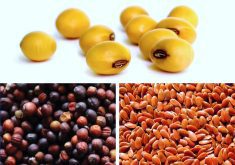Grain and oilseed futures at the ICE Canada futures market have moved higher since my last column. Canola advanced in the wake of sharp gains in the U. S. soy complex. Commercial demand lifted the market with crushers the best buyers as crush margins improved to the best levels in five years. There was some fresh export demand in the market and farmer selling slowed a bit. Commodity funds were steady, but not heavy, buyers as technical signals were also positive. The firm Canadian dollar and the large canola supply being held on-farm weighed on the market. Western barley also saw modest gains as sluggish feedlot demand was balanced off by slow farmer selling.
Read Also

Brazil muscles into wheat market
Glacier FarmMedia – Canadian wheat exporters are facing a new competitor in their second biggest market. “The rapid emergence of…
Chicago futures were mainly higher. Soybeans advanced on strong export demand and revisions lower in the drought-stressed Argentine soybean crop. China continued to be an outstanding buyer. Friendly technical signals triggered heavy speculative buying as well. U. S. corn futures posted gains early following the U. S. soy market. Prices hit over $4/bu. as export demand remained strong. However values have backed down from their highs on concerns about domestic demand and improved weather for planting the U. S. corn crop. Questions about future ethanol use and feedlot demand also weighed on values.
U. S. wheat futures saw small losses in all three U. S. wheat futures markets. Sluggish fresh export demand accounted for most of the downside pressure. Continued concerns about the stressed U. S. winter wheat crop and lower spring wheat acres due to flooding in North Dakota underpinned values keeping prices little changed.
U. S. soybean futures have hit six-month highs as the exceptional export demand boosted futures past the $10/bu. level. China was behind most of the run-up in prices. However, support could also be traced to the reduced Argentine soybean crop. Argentine sources have now estimated their crop at 37 million tonnes, down from an earlier estimate of 39.5 million tonnes and early forecasts for a crop of over 50 million tonnes.
Be aware. The function of this move higher is to STOP the buying. It is felt that soybean prices are approaching levels that will cause China to shift its buying to South America. Talk in the trade was that U. S. 2008-09 soybean ending stocks will fall to 100 million bushels from the April USDA report forecast of 165 million bushels. This is extremely tight and it is thought that U. S. ending soybean stocks can not fall below 100 million bushels.
This is good news for 2009-10 oilseed (including canola) prices as the expectation for record-large 2009 U. S. soybean acres has caused new-crop soybean prices to drop to an almost $1/bu. discount to the old crop. However, if 2008-09 ending stocks do drop as low as 100 million bushels, a record U. S. soybean crop, expected at 3.3 billion bushels, will have a more limited negative impact on oilseed prices in 2009-10.
Be aware also that once the market achieves its aim of stopping Chinese buying, prices could drop very sharply because of the large speculative component.
The canola market was supported by soybeans, but where U. S. soy old-crop futures rose 25 per cent from Feb. lows, canola saw gains of only about 12 per cent from its Feb. lows. The large supply of canola in Western Canada accounts for the poorer performance of the canola market, despite the pretty impressive fact that farmers have marketed over eight million tonnes this crop year.
Also giving good support to canola was the move by crush margins to their best profitability since 2004. What stimulated that was tightening global vegetable oil supplies which caused soyoil, palm oil and sunflower oil to all trade at similar prices recently. This is an unprecedented event.
The smaller rally in canola should also mean that it will not follow the soybean market down as far. However, it is still possible that we could see a drop of as much as $1/ bu. in canola prices when the U. S. soy tumble begins.
Ethanol usage and its status as a “clean” fuel is coming to the foreground in the U. S. as California is expected to issue a proposal that could limit the use of ethanol in the state. They are reviewing the clean fuel status of ethanol. One of the new regulations that they are looking at for ethanol’s environmental “cleanness” status involves the land-use changes. If land is cleared of plants or trees that absorb more greenhouse gases than corn plants, that will be taken into account in declaring the level of ethanol is cleanness.
The U. S. Envi ronmental Protection Agency is studying a similar rule which would affect ethanol’s rating as a clean fuel in all of the U. S. The EPA is also looking to include in the ethanol rating the fuels used to produce the energy that runs the ethanol plants as part of the environmental rating of ethanol. This means that ethanol producers that use electricity from coal-fired generating plants would be more “dirty” than ethanol produced at plants using electricity from nuclear-generating or hydro plants.
The EPA is also considering allowing U. S. gasoline producers to use up to 15 per cent ethanol in their fuel mixture. The proposal is being fought by the automobile companies who point out that new car warranties specify that ethanol cannot comprise more than 10 per cent of the fuel used in the car in order for the warranty to remain valid.
With corn usage for ethanol in 2009-10 expected to be between 4.0 billion to 4.3 billion bushels these questions will have serious implications not only for corn prices, but for all feed grain markets, including barley.
There are some larger weather anomalies that seem to be developing. The question of whether we will see an El Nińo event this year has appeared. That weather phenomenon usually causes palm oil production in Southeast Asia to decline and also results in disastrous droughts for the Australian wheat crop.
So far the great trade winds over Southeast Asia have started to slow and the Pacific Ocean in the area has started to warm. These are a precursor to El Nińo. We will know if this weather anomaly is developing by the end of May.
The other potential weather factor to be aware of, although there has been no sign of it, is drought for the U. S. Midwest. Many farmers are familiar with the 19-year drought cycle in the U. S. Midwest. This cycle has been recorded in nature for the last 800 years.
The longest time that has ever occurred between these Midwest droughts has been 23 years. The last major drought in the U. S. Midwest was in 1988. That means that the likelihood of drought in the U. S. Midwest either this year or next year is exceptionally high. In 1988, the drought did not start to appear in the markets until the third week of May and was confirmed as a major drought in the market by the middle of June.














